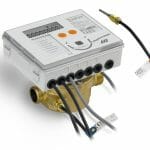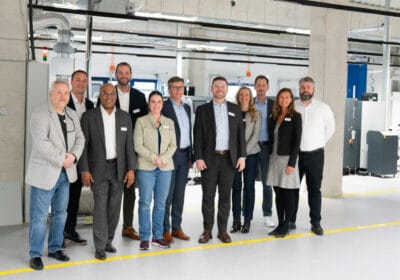Turning water and wastewater pumping systems into intelligent devices.
With demand for water and wastewater treatment on the rise, the operators tasked with keeping it all flowing face daunting challenges on several fronts. Industrial Internet of Things (IIoT) technologies, including edge computing, may provide the answer for creating the efficient, self-optimizing distribution infrastructures needed to meet today’s growing demands in the face of flat budgets.
The need for greater efficiency
At the top of the priority list is the need to increase the efficiency and reliability of pumping systems. Reducing energy consumption is a critical focus for both municipal and commercial operations. This is driving the continuing movement away from single-speed pumps and the adoption of variable-speed pumps that can satisfy flow requirements while using significantly less energy. While they offer attractive advantages, variable-speed pumps are more sensitive and require more monitoring than traditional single-speed pumps.
Operators also face expanding regulations governing water quality and effluent safety. In some cases, continuous monitoring is required to ensure regulations are met, avoiding costly fines.
Finally, there is the challenge of the aging workforce responsible for operating complex water distribution and wastewater treatment infrastructures. As those workers retire and leave the field, they are taking an immense amount of institutional knowledge with them. As younger, less experienced workers take their places—and as staffing budgets are constrained—the need to rely less on human intervention is becoming critical.
Enter the intelligent edge
To meet these challenges, forward-looking water and wastewater system operators are turning to IIoT technologies, including distributed sensors and edge computing systems that bring intelligence right to the pumps and controllers doing the work. Edge systems provide the computing necessary to perform sophisticated monitoring and control of sensitive pumping systems that need to run 24x7x365, often located in remote, unstaffed locations.
Gathering and analyzing data from a host of sensors on critical pumping components in real time, edge computing systems can perform a wide range of high-value applications. If critical performance parameters, such as temperature or vibration, are found to be out of range by the edge system in that location, the pump could be automatically shut down to prevent damage, with the system sending a real-time alert back to the central control facility.
Even more valuable is the ability to continuously gather data on pump performance and perform analytics to proactively determine when periodic maintenance is required. This “predictive maintenance” analysis can significantly reduce unplanned downtime while extending the lifespan of costly pumps and components. This is especially valuable where sensitive variable-speed pumps are deployed.
Limitless possibilities
Given the flexibility of edge computing platforms, the possibilities for optimizing operations is limitless. Chemical treatment of water or wastewater can be automated with edge systems that analyze the chemical makeup of water or effluent in real time, minimizing the need for human intervention while maintaining optimal quality.
Leak detection is another application where IIoT sensors and edge computing systems can play an invaluable role. Edge systems can continuously analyze flow data and pinpoint problem areas with unprecedented speed. In fact, edge computing has a role to play at source locations and distribution points throughout the infrastructure, wherever data can be gathered, analyzed and acted upon to reduce energy use, minimize human interaction and maximize efficiency and uptime.
Evolution, not revolution
In the real world of water and wastewater operations, realizing the intelligent edge will be an evolutionary process. The plan: Start small and build on success.
The first step is to clearly understand what you are trying to achieve—how will you define success? Then start with a limited pilot program with clear objectives. For example, an edge system might be deployed at a remote pumping station to collect sensor data over a period of time and perform simple analytics on pump performance. Periodically, a technician could visit the site and connect to the edge system using a tablet or mobile phone and review pump performance—without the complexity or expense of sending the data up to the cloud for analysis.
When you are ready to scale up your intelligent edge infrastructure, this pilot approach can be replicated at key locations as budget realities permit. This enables you to localize computing without having to invest in a lot of costly infrastructure. Ultimately, this can evolve into a “hybrid cloud” approach where local edge systems perform real-time monitoring and control functions, sending data relevant to longer-term planning up to the cloud for deeper historical analysis.
Keep it simple and reliable
When embarking on your edge computing journey, it is critical to deploy systems that are specifically designed for the task. Because IT skill sets are often in short supply in water/wastewater operations, edge systems must be simple to deploy and easy to maintain, including support for remote system management and servicing. It is also essential that edge systems be fault-tolerant to ensure continuous availability, and self-protecting to ensure valuable data is never lost. As data accumulates in both volume and value, the need to safeguard it becomes mission-critical.
Making the case for the intelligent edge
The business case for IIoT and edge computing is already well established in commercial process industries. In the oil and gas industry, edge systems are used to monitor far-flung pipeline pumping and compressor stations, identifying potential performance problems before they interrupt the flow of product or cause an environmental disaster.
In the food and beverage industry, edge computing is playing a variety of roles, including real-time quality monitoring on the production line and in product traceability, accelerating the tracing of raw material source in the event of contamination. These innovations are helping protect the quality and safety of food, and minimize the risk of a debilitating recall.
For these industries, where the performance of pumps and other critical components impacts their bottom line, the decision to deploy IIoT sensors and intelligent edge systems is an easy case to make. For water and wastewater system operators, the case for an incremental approach to edge computing that targets key points of potential efficiency gains and/or component failure is just as strong.





